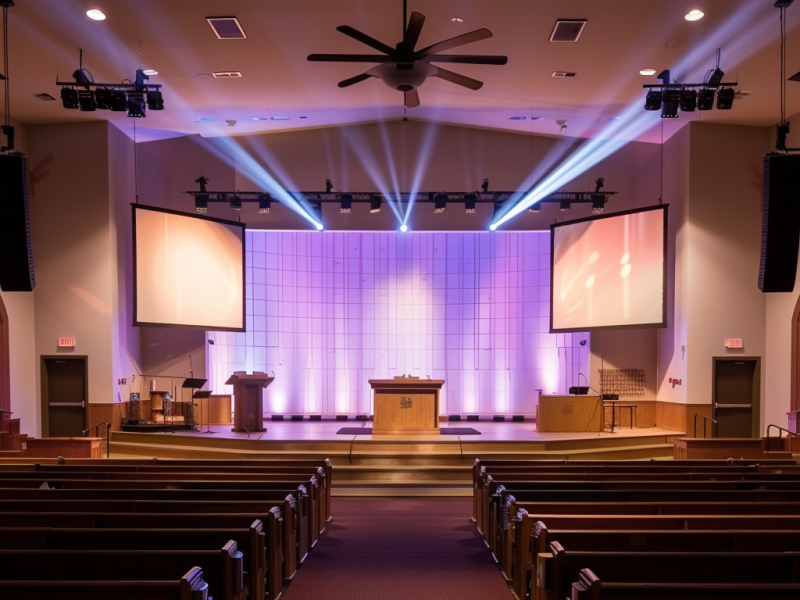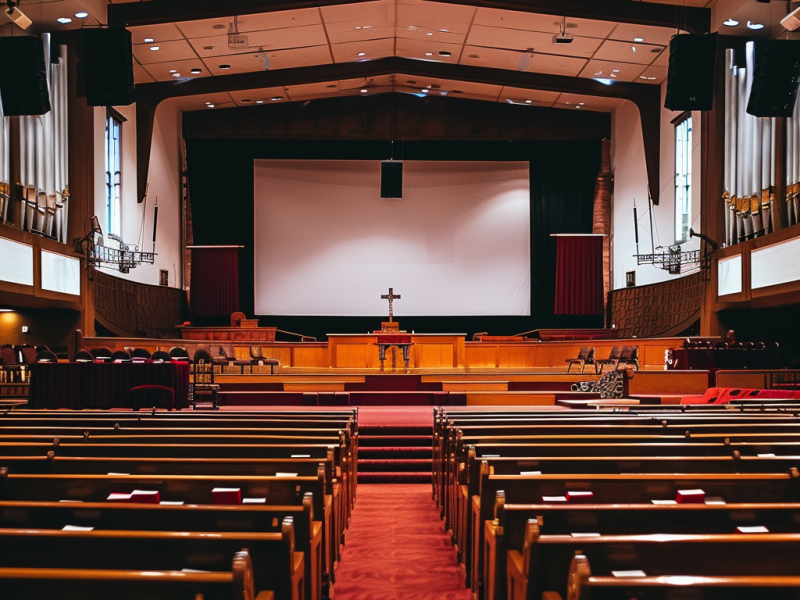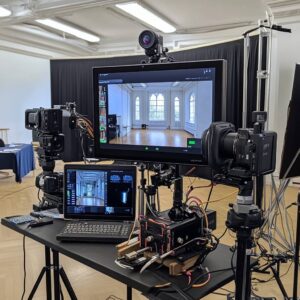The essential guide to church live streaming: equipment, setup, and best practices
In today’s digital age, live streaming has become essential for churches to connect with their congregation and reach a wider audience. The ability to broadcast services, events, and messages in real time allows for greater accessibility and engagement, especially when physical attendance is limited. As the demand for online church services grows, so does the need for quality audio-visual (AV) equipment and expertise to ensure a seamless and impactful live-streaming experience.
In this comprehensive guide, we’ll explore the key aspects of church live streaming, from understanding the importance of this technology to selecting the right equipment and setting up your system for success. Whether you’re new to live streaming or looking to enhance your existing setup, this post will provide valuable insights and best practices to help you create meaningful and engaging online worship services.

The Importance of Live Streaming for Churches
In recent years, live streaming has transitioned from a luxury to a necessity for modern churches. In fact, around 27% of U.S. adults regularly watch religious services online or on TV. This digital transformation has been propelled by various factors, making live streaming an integral part of ministry. Here are some key reasons why live streaming is essential for churches today:
- Expanding Reach: Live streaming breaks down geographical barriers, allowing churches to connect with members who cannot attend in person due to distance, health issues, or other constraints. It enables the church’s message to reach a global audience, attracting new followers and spreading the church community and word far beyond the physical walls of the building.
- Enhancing Accessibility: For congregants who are elderly, ill, or have mobility challenges, live streaming ensures they can still participate in worship and remain connected to their faith community. It provides an inclusive experience, ensuring everyone can access spiritual guidance and support.
- Building Community: Live streaming creates a virtual space where church members can gather, pray, and worship together, fostering a sense of community and belonging. This is especially important in times of crisis or social distancing when physical gatherings are impossible.
- Supporting Outreach and Evangelism: Live streaming is a powerful tool for outreach, enabling churches to share their message with a broader audience. It can be a gateway for non-believers or those seeking spiritual guidance to explore faith and connect with the church.
- Adapting to Changing Times: The digital age has transformed how people communicate and consume content. Churches that embrace live streaming are adapting to these changes, staying relevant, and meeting the needs of a tech-savvy generation.
In essence, live streaming is more than just broadcasting services; it’s about extending the church’s reach, enhancing accessibility, nurturing community, supporting evangelism, and adapting to the digital era. It invests in the church’s future and mission to connect with and serve a wider community.
Overview of Live Streaming Equipment
Having the right equipment is crucial to ensure a high-quality live streaming experience. While the specific needs may vary depending on the size and requirements of your church, here’s a general overview of the essential components for a basic live-streaming setup:
- Camera: The cornerstone of your live streaming setup is a good camera. Options range from professional-grade camcorders to more affordable consumer cameras. For enhanced image quality, consider cameras with HD or 4K resolution. Some churches may opt for multiple cameras to capture different angles and provide a dynamic viewing experience.
- Microphone: Clear audio is just as important as clear video. Depending on your setup, you might need a lapel microphone for the speaker, handheld microphones for singers, or a shotgun microphone to capture ambient sound. Investing in a good-quality microphone ensures your message is heard loud and clear.
- Audio Mixer: An audio mixer is essential for managing and balancing multiple audio inputs, such as microphones and instruments. It allows you to control the volume levels and ensure a harmonious blend of sounds.
- Video Encoder: A video encoder converts the video signal from your camera into a format suitable for streaming. Hardware encoders provide high-quality, reliable performance, while software encoders offer a more budget-friendly option.
- Streaming Software: This software is the control center for your live stream. Streaming software allows you to mix video and audio sources, add graphics or overlays, and manage your stream’s output. Popular options include OBS Studio, Wirecast, and vMix.
- Internet Connection: A stable and fast internet connection is crucial for live streaming. Ensure that your upload speed is sufficient to handle the stream’s bitrate without buffering or interruptions.
Investing in the right equipment and ensuring compatibility among the components allows you to create a professional-quality live-streaming setup that delivers a seamless and engaging experience for your online congregation.

Basic Setup Considerations
Setting up a live streaming system involves more than just assembling equipment; it requires thoughtful planning and attention to detail. Here are some key considerations to ensure a smooth and professional live-streaming experience:
- Camera Placement: The placement of your camera is crucial for capturing clear and engaging visuals. Position the camera at eye level to create a more personal connection with the online audience. Consider the background and framing, ensuring it’s visually appealing and free from distractions. For larger churches or more dynamic services, multiple cameras can capture different angles and add variety to the stream.
- Lighting: Good lighting is essential for high-quality video. Natural light is ideal, but it can be unpredictable. Supplement with artificial lighting to eliminate shadows and ensure even illumination. Soft, diffused light sources are preferable to avoid harsh shadows or glare.
- Audio Quality: Clear audio is critical for a successful live stream. Use high-quality microphones and position them strategically to capture clear sound without background noise. An audio mixer can help balance different audio sources for a harmonious output.
- Internet Connectivity: A stable and fast internet connection is vital for your stream setup. Wired connections (Ethernet) are generally more reliable than wireless ones (Wi-Fi). Test your upload speed to ensure it can handle the stream’s bitrate without buffering or interruptions.
- Test Runs: Before going live, conduct test runs to check the audio and video quality, lighting, and internet connectivity. This will help identify and resolve any issues in advance.
- Backup Plan: Always have a backup plan in case of technical difficulties. This could include backup equipment, alternative streaming platforms, or pre-recorded content to fill in gaps.
By considering these factors and planning accordingly, you can set up a live streaming system that delivers a high-quality and engaging experience for your online audience.

Key Best Practices for Successful Church Live Streaming
To ensure your church’s live streaming efforts are successful and impactful, following some key best practices is important. These guidelines will help you create a high-quality and engaging livestream that resonates with your online audience:
- Engage with Your Online Audience: Treat your online viewers as an integral part of your congregation. Acknowledge their presence, encourage participation through comments or live chat, and address them directly during the service. This fosters a sense of inclusion and community.
- Maintain High-Quality Audio and Video: Invest in good quality equipment and ensure proper setup to deliver clear audio and crisp video. Regularly monitor and adjust sound levels and lighting during the stream to maintain consistency.
- Plan and Rehearse: Preparation is key to a smooth live stream. Plan the order of service, including any special segments or announcements. Conduct rehearsals to iron out technical issues and ensure everyone knows their role.
- Use Lower Thirds and Graphics: Enhance your live stream with lower thirds (text overlays at the bottom of the screen) to display song lyrics, scripture references, or speaker names. Graphics and visuals can add depth and context to your stream.
- Monitor and Moderate the Chat: If you have a live chat feature, assign someone to monitor and moderate it. This ensures that the conversation remains respectful and relevant and allows for real-time engagement with viewers.
- Archive and Share the Stream: After the live stream, archive the video and make it available for on-demand viewing. Share the link on your church’s website and social media channels to reach a wider audience.
By implementing these best practices, you can create a live streaming experience that delivers high-quality audio and video and fosters a sense of connection and community among your online congregation.

Next Steps
As we’ve explored in this guide, live streaming is an invaluable tool for modern church services, enabling houses of worship to reach and engage with a wider audience in a meaningful way. By investing in the right pieces of equipment, paying attention to setup considerations, and following best practices, your church can create a high-quality live-streaming experience that brings your congregation together, no matter where they are.
While this overview provides a solid foundation, there are many more details for each live-streaming aspect. In the coming weeks, we’ll dive deeper into topics such as selecting the best live streaming equipment for your church, optimizing your setup for flawless streaming, and integrating your live stream with your church’s sound system. Stay tuned for these detailed guides that will help you enhance your church’s live-streaming capabilities.
If you’re looking for expert assistance in setting up or upgrading your church’s live streaming system, RYGID AV is here to help. With our extensive experience in audio-visual installations and production, we can provide tailored solutions to meet your church’s unique needs. Contact us today to learn more about how we can support your live-streaming journey.
Live streaming is more than a technological advancement; it’s a powerful ministry tool that can extend your church’s reach and impact. Embrace the possibilities and start your live-streaming journey with confidence.



